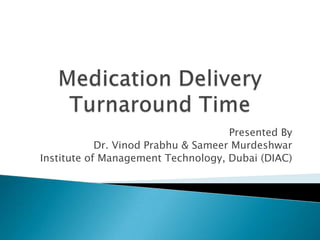
Medication Delivery Turnaround Time
- 1. Presented By Dr. Vinod Prabhu & Sameer Murdeshwar Institute of Management Technology, Dubai (DIAC)
- 2. Objectives of the Study Brief History of Six Sigma Six Sigma in the Healthcare Industry Time frame End Outcome The DMAIC Methodology ◦ Define ◦ Measure ◦ Analyze ◦ Improve ◦ Control
- 3. To look for an existing process in the hospital which has a scope for significant improvement Six Sigma methodology would be the choice for the process improvement Chosen focus area is the Medication Delivery Turnaround Time for newly admitted patients
- 4. Blakslee (1999, July) refers to Six Sigma as “a high-performance, data-driven approach to analyzing the root causes of business problems and solving them” Originally developed by Bill Smith, a reliability engineer working for Motorola in 1986 Adopted by GE in the 1990s
- 5. Ever-growing number of health care organizations are using Six Sigma to improve processes from admissions to discharges and all the administrative and clinical processes in between Driven by several factors including the need to improve the organization’s bottom- line, eliminate medical errors and position themselves for an imminent global customer - centred health care revolution
- 6. Using the DMAIC methodology, the study was spilt into five phases ◦ Define phase (10 days) ◦ Measure phase (30 days) ◦ Analyze phase (10 days) ◦ Improve phase (15 days) ◦ Control phase (5 days)
- 7. Significant improvement in the existing process Greater customer & employee satisfaction Streamlining of the process Savings in terms of time – Medication Delivery Turnaround Time for newly admitted in- patients
- 8. Flexible, but powerful set of five steps for making improvements happen and stick The team works from a statement of the problem to the implementation of the solution, with statistical driven activities in between
- 9. Define the problem Identifies potential projects, selects and defines a project, and sets up the project team Selection of the project depends on it’s feasibility, significance and measurability Started out with mapping the complete process for three processes ◦ Patient admission (IP) ◦ Outpatient procedure ◦ Working of pharmacy
- 10. Initially chose OP process but… Finally, focus area shifted to the IP process for newly admitted patients requiring medications upon admission Main reason being the complexity of interactions & process flow and the larger number of variables Drew up a timeline & chalked out a project blueprint
- 11. Organization: Zulekha Hospital, Sharjah Champion: Dr. Suresh Menon Project Owner: Dr. Alexander Varghese Project leader: Ms. Pooja George Project: Medication Delivery TAT for Newly admitted patients Problem statement: Long waiting times for a newly admitted patient to receive their first medication Project objective: To reduce the patient waiting times for medication Project Team: Dr. Vinod Prabhu & Sameer Murdeshwar Metrics: Minutes CTQ: Quicker drug dispensation
- 12. Data is gathered to validate and to quantify the problem / opportunity Begin testing out facts and numbers that offer clues about the causes of the problem Identify key parameters and process characteristics Process was observed for 3 – 4 days Questioned people involved for clarification Process was divided into 9 distinct steps and individually measured Total of 40 cases were measured, across all three wards and different shift timings Daycare cases and delayed medication cases were not taken into consideration Took care to be as discreet as possible so as to not introduce bias into the study
- 15. Identifies the causes of the problem From the various causes, the focus will be on the root cause(s) Begins by combining data, experience, a review of the process, and then forming an initial hypothesis of the cause Root Cause analysis performed Ishikawa (Cause & Effect) Diagram was constructed Pareto Analysis performed Quantitative drill down of the measured numbers – Averages, Max time, Min time & Frequency distribution
- 17. 25.00 Average Time of Each Process 20.00 Time in Minutes 15.00 10.00 5.00 0.00 1 2 3 4 5 6 7 8 9 Series1 5.99 10.61 6.40 2.58 0.78 8.15 3.26 2.69 23.73
- 18. % Contribution of each Step to Total Time 40 35 30 25 Percentage 20 15 10 5 0 1 2 3 4 5 6 7 8 9 Series1 9.33 16.54 9.97 4.01 1.22 12.7 5.07 4.19 36.97
- 19. Pareto Chart for Stage Wise Delay 120 100 80 Percentage 60 40 20 0 k c h de ab i j f g Series1 36.974878 16.535150 12.699513 9.9696202 9.3324245 5.0726387 4.1850048 4.0144109 1.2163583 Series2 36.974878 53.510029 66.209542 76.179162 85.511587 90.584225 94.769230 98.783641 100
- 20. Major Causes Instances Multitasking-doctor enquiries and patient room calls 10 Nurses handling other recent admissions 9 Nurses focus on doing the paper work 6 Indent not kept on shelf immediately after print out taken 6 HK busy with their primary work 5 Distractions-Telephone calls 2
- 21. Designs a remedy, help prove its effectiveness, and prepares an implementation plan Several potential solutions have to be proposed Criteria, including costs and likely benefits are used to select the most practical solutions
- 22. Process Re-Design Dedicated Housekeeping staff to deliver medications from pharmacy to all wards Medical file re-design Use of digital clocks Printing priority Discharge sheet proposal
- 23. Avoiding the “snap” back to old habits and processes Ensuring that the solution has a long-term impact Developing a monitoring process to keep track of the changes Creating a response plan for dealing with problems that may arise